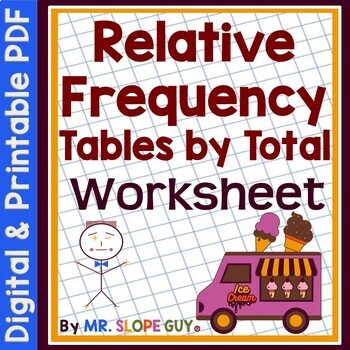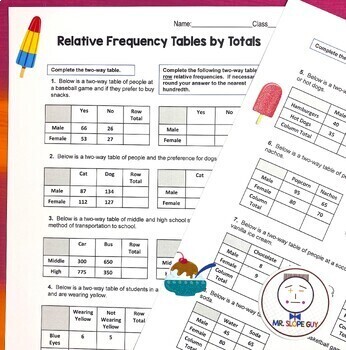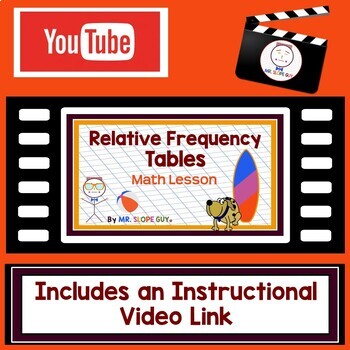Relative Frequency Two Way Tables by Total Row or Column Worksheet
- PDF
- Easel Activity
What educators are saying
Also included in
- Six math worksheets and one quiz targeting widely tested state math standards focusing on Bivariate Data concepts including Scatterplots and Two-Way Tables, Relative Frequency Tables and Residuals. Each include a printable PDF, Five include corresponding Easel Activities.WorksheetsScatterplots WorksPrice $14.99Original Price $19.40Save $4.41
Description
Attention Math Teachers! Enhance your students' understanding of relative frequency tables with our Two-Way Tables Worksheet. This two-sided worksheet is designed to help students create accurate relative frequency tables from basic information given in the form of a two-way table.
The worksheet focuses on completing tables when using the totals by either the row or the column equal to 1.00. By practicing this skill, students will strengthen their ability to analyze data and draw conclusions.
With an easy-to-use answer key included, this worksheet is perfect for in-class assignments or homework. It's appropriate for both Pre-Algebra and Algebra 1 classes.
Don't let your students struggle with creating relative frequency tables any longer. Download this Two-Way Tables Worksheet today and help them develop this essential data analysis skill.
Formats
You will have two convenient formats for this activity, so you can choose the one that best suits your needs and teaching style.
The first format is a PDF that can be printed and used as a worksheet in the classroom. The two-sided printout includes a key, making it easy for you to grade and provide feedback to your students.
The second format is an Easel Activity, which allows you to assign the activity online for your students to complete on their own devices. This option is perfect for distance learning or for assigning homework. Simply assign the activity through your school's learning platform, including Google Classroom and Schoology. Your students will be able to complete the activity online and submit their answers for grading.
So whether you prefer a traditional printed worksheet or an online activity, I've got you covered. Choose the format that works best for you and give your students the tools they need to succeed in math!
Instructional Math Video
In order to provide the best possible learning experience for your students, I've included a QR code link to a video that I created to assist with using this worksheet. While the video is not professionally produced, it can be an incredibly helpful tool for students who are learning remotely, were absent during the activity, or are homeschooling. Additionally, it can serve as a substitute lesson plan in case of unexpected absences or classroom disruptions.
The video includes several examples and provides step-by-step instructions that can help students complete the activity successfully. By offering this additional resource, we hope to provide your students with the support they need to master the concepts covered in the worksheet.
Math Standards
Aligned with common core standards CCSS HSS-ID.B.5. Florida’s B.E.S.T. math standards MA.912.DP.3 Solve problems involving categorical data. MA.912.DP.3.1 Construct a two-way frequency table summarizing bivariate categorical data. Interpret joint and marginal frequencies and determine possible associations in terms of a real-world context. MA.912.DP.3.2 Given marginal and conditional relative frequencies, construct a two-way relative frequency table summarizing categorical bivariate data. MA.912.DP.3.3 Given a two-way relative frequency table or segmented bar graph summarizing categorical bivariate data, interpret joint, marginal and conditional relative frequencies in terms of a real-world context.
Check out some of my other Math Worksheets
Two Way Tables Statistics Worksheet
Relative Frequency Tables Worksheet
Mr. Slope Guy
Teacher Feedback
"I used this as a review for those struggling with Two-way tables and they enjoyed the practice!"
"This was a great supplemental resource. This provided extra practice for a very difficult concept."
"Great resource to use for breaking material down! Helped students very much!"
LICENSING TERMS: This purchase includes a license for one teacher only for personal use in their classroom. Licenses are non-transferable, meaning they cannot be passed from one teacher to another. No part of this resource is to be shared with colleagues or used by an entire grade level, school, or district without purchasing the proper number of licenses. If you have any questions, please contact me at MrSlopeGuy@gmail.com.
COPYRIGHT TERMS: This resource may not be uploaded to the internet in any form, including classroom/personal websites or network drives, unless the site is password protected and can only be accessed by students.







